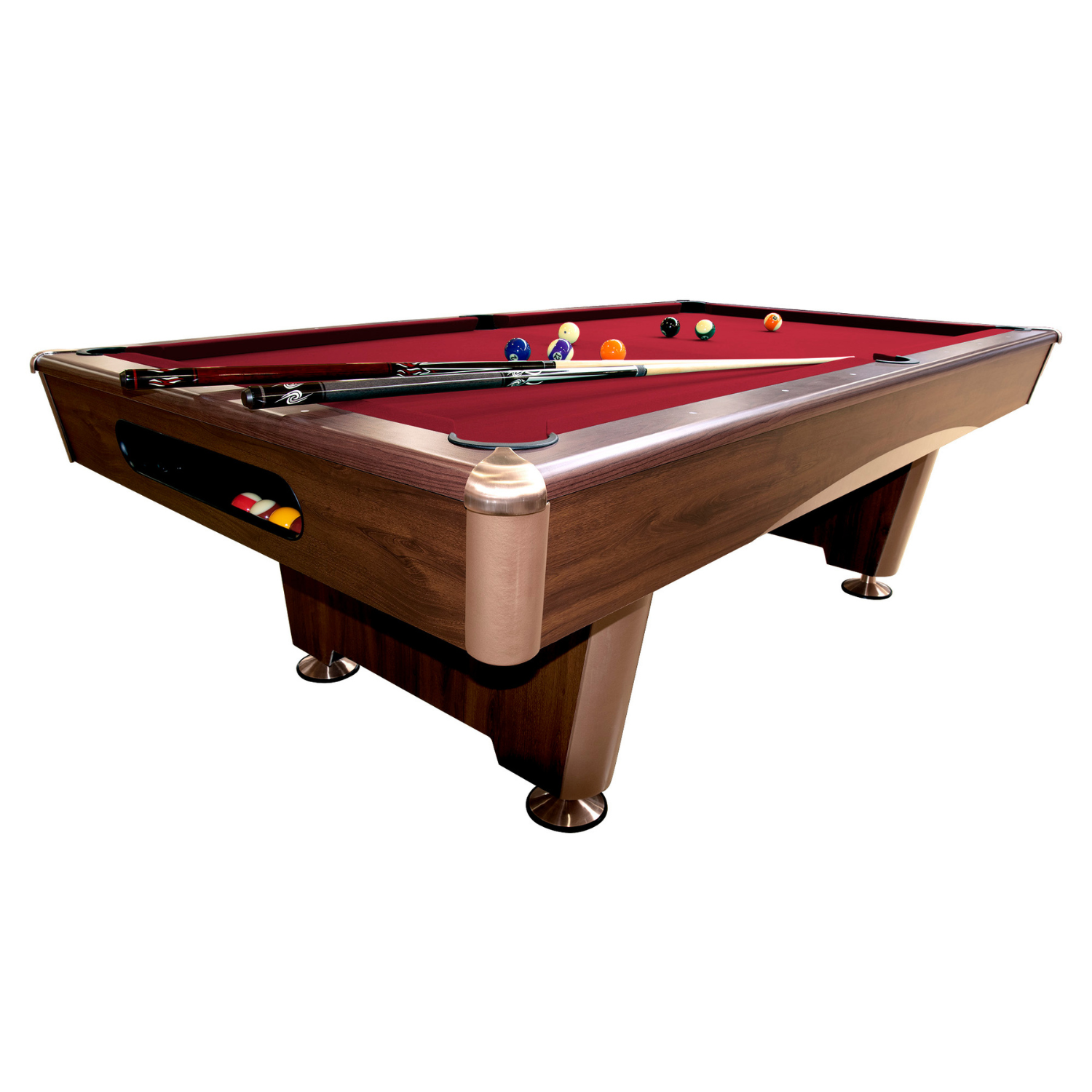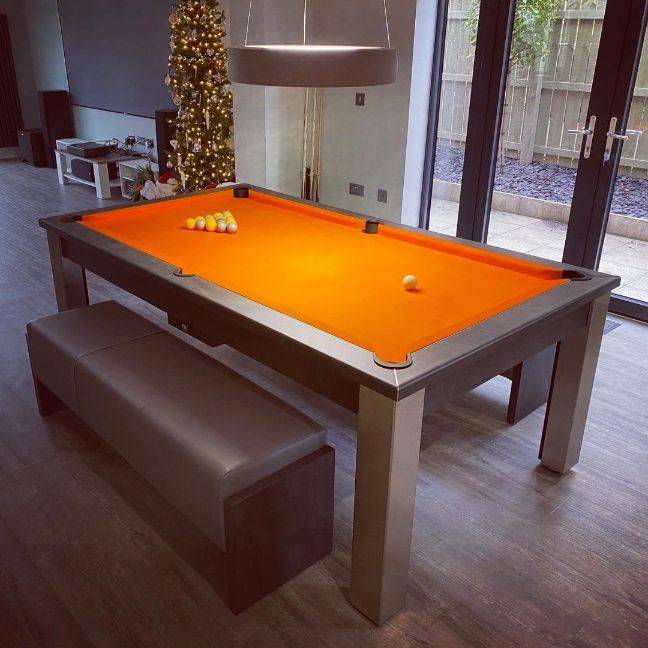From Slate to Design: Breaking Down the Cost of a UK Pool Table
Purchasing a pool table in the UK is not merely an investment in recreation; it’s an investment in craftsmanship, design, and the long history of a beloved game. Whether stationed in a cosy pub or a private games room, a pool table becomes the centrepiece of any space. However, the broad range in prices can be puzzling for potential buyers. This article delves into the core components and design aspects of pool tables, demystifying the costs associated with each element.

1. The Foundation: Slate vs. MDF
- Slate: The crème de la crème of pool table surfaces. Extracted from quarries, slate provides a perfectly flat surface, ensuring smooth ball movement. Its longevity and resistance to warping contribute to a higher cost, accounting for a significant portion of a premium table's price.
- MDF (Medium Density Fibreboard): A cheaper alternative to slate, MDF is a type of hardboard made from wood fibres glued under heat and pressure. While suitable for casual play and lighter on the pocket, MDF tends to warp over time, especially in humid conditions.
2. Cloth Quality: The Green Expanse
The cloth, often green (though available in various colours), covers the table's playing surface. Its quality directly impacts gameplay.
- Woolen Cloth: Traditional, heavy, and slow, woolen cloth is commonly found in pub tables across the UK. Its nap requires regular brushing.
- Worsted Cloth: Faster and smoother, worsted cloth (often branded as "speed cloth") is favoured for professional play. Made of combed wool, it's nap-free and more expensive.
3. Frame and Leg Construction: Holding It All Together
- Solid Wood: Tables with frames and legs made from solid hardwoods like oak or mahogany are durable and elegant. This robust construction, paired with intricate designs or carvings, can significantly elevate the price.
- Metal and Composite Materials: Modern tables, especially those with a sleek or minimalist design, might employ metal frames and legs. While durable, they're typically less expensive than their hardwood counterparts.
4. Pocket Craftsmanship
- Leather Pockets: Traditional leather pockets, especially hand-stitched variants, add both function and aesthetic appeal. Their craftsmanship can contribute to the table's overall cost.
- Plastic or Rubber Pockets: Common in economical tables, these pockets serve the purpose but lack the charm and durability of leather.
5. Design and Customisation
- Standard Designs: Mass-produced tables with standard designs are usually more affordable. They cater to a broad audience and are ideal for casual players or budget-conscious buyers.
- Custom Tables: Tailored to individual preferences, custom tables are unique. Whether it's a particular wood finish, custom leg design, or an engraved plaque, personalisation adds to the cost.

6. Additional Features
- Ball Return System: Found in many commercial tables, this system automatically returns potted balls, saving players from fishing them out of pockets. Its inclusion can raise the table's price.
- Dining Top: Some pool tables come with removable tops, transforming them into dining tables. This dual functionality can increase the cost.
7. Brand and Heritage
Like any other product, brand reputation and heritage play a role in determining the price of a pool table. Established brands, with a history of crafting tables for championships or royal estates, command a premium.
8. Installation and Aftercare
The cost doesn’t end once you’ve chosen your table. Installation, especially for slate tables, requires professionals. Additionally, maintenance tools like brushes, covers, and occasional re-clothing add to the overall investment.
9. Regional Craftsmanship
The UK is renowned for its distinct regional identities, and pool table craftsmanship is no exception.
- Yorkshire Craftsmanship: Historically associated with textile manufacturing, Yorkshire offers some of the finest cloths, often sourced locally, adding a touch of regional pride and consequently, a premium to the table's cost.
- Cornish Slate: While slate is a common material for table beds, Cornish slate, known for its impeccable quality and smooth finish, can add to the exclusivity and price of the table.
10. Accessories and Kits
Often overlooked, the accessories that come with the table, or are purchased additionally, can influence the overall cost.
- Standard vs. Custom Cues: While most tables come with a standard set of cues, customised or branded cues, made from superior materials with ergonomic designs, can elevate the playing experience and the price.
- Balls: Aramith balls, made of phenolic resin, are considered top-of-the-line and are more expensive than standard polyester balls.
11. Table Size and Portability
- Size Matters: A full-size professional table (7ft) will generally be more expensive than its smaller counterparts, primarily due to the materials required.
- Portability Features: Tables designed with foldable legs or wheels for easy movement can be pricier due to the added functionality.
12. Environmental and Ethical Considerations
- Sustainability: Eco-conscious manufacturers might use sustainably sourced wood or recycled materials. While these tables might carry a higher price tag, they cater to a growing market that values ethical production.
- Fair Trade Compliance: Brands that ensure fair wages and working conditions for their craftsmen might price their tables higher to reflect these ethical considerations.
13. Vintage and Antique Tables
History carries a price. Vintage or antique tables, especially those from renowned manufacturers or with a storied provenance, can fetch a much higher price than contemporary tables. Their intricate designs, seasoned wood, and historical significance add layers of value.
14. The Intangibles
- Warranty & Service: Brands that offer extended warranties or complimentary servicing can have higher upfront costs but provide peace of mind in the long run.
- Exclusivity Factor: Limited edition designs, collaborations with renowned designers, or tables associated with significant events (like championship tables) carry an exclusivity factor, pushing their price upwards.
Understanding Value Over Cost
While breaking down the cost provides clarity, it's essential to understand the value behind each pound spent. A high-quality slate table, though expensive, offers an unparalleled playing experience and lasts for generations. On the other hand, an MDF table, while perfect for occasional games, might not withstand the rigours of regular play.

Conclusion
In the end, the cost of a UK pool table is a sum of its parts, design choices, brand legacy, and the experience it promises to deliver. Whether you're an enthusiast seeking a table for spirited games with friends, a professional aiming for precision, or someone seeking a blend of form and function, understanding the breakdown helps in making an informed decision. Remember, a pool table is not just a purchase; it's an investment in countless hours of joy, competition, and camaraderie.
Are you looking for a Pool Table? check out our pool tables range Pool Tables





